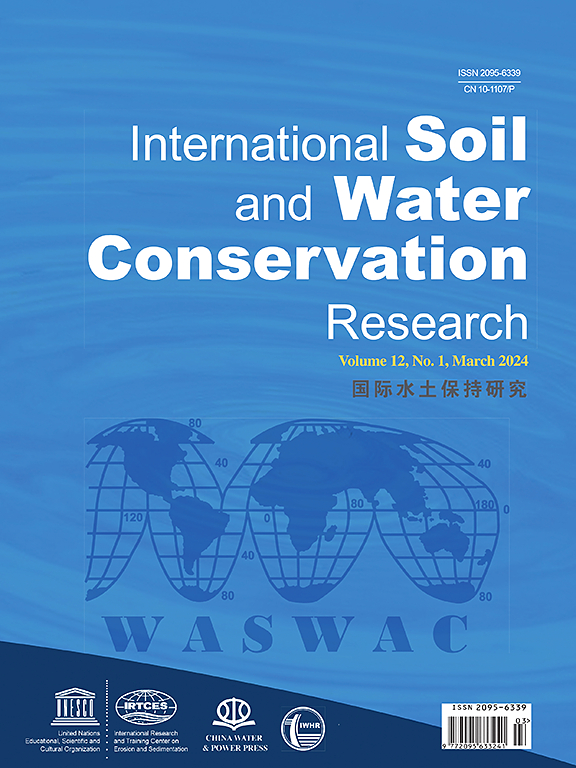Soil degradation: An integrated model of the causes and drivers
IF 7.3
1区 农林科学
Q1 ENVIRONMENTAL SCIENCES
International Soil and Water Conservation Research
Pub Date : 2025-07-21
DOI:10.1016/j.iswcr.2025.07.010
引用次数: 0
Abstract
Soil plays a critical role in seven existential challenges that threaten sustainable development of human society. However, despite this integrative role, humans generally focus on the use of soil to produce the 98.8 % of calories that the growing human population demands while failing to appreciate the less tangible role of soil in other existential challenges such as climate change abatement. Our current agricultural management approaches are causing ongoing soil degradation, manifested as the loss of soil organic matter, acidification, over-application of fertilizers, erosion, salinization, contamination, and biodiversity loss. However, to develop workable, sustainable, and equitable solutions, these proximate causes of degradation need to be considered in combination with the socio-economic factors that are the underlying drivers of this soil degradation, including the economic drivers, land pressure, poverty, security of land tenure, the differences between on-site and off-site impacts of degradation, and the impact of policies. Consideration must also be given to the importance of both intergenerational and developmental equity, whereby the current generation considers future generations, and where developed countries consider those that are still developing. Through this approach, we present a novel, integrated framework for soil degradation that bridges biophysical and socio-economic dimensions of soil degradation, with this providing an approach for advancing global soil security as required to maintain planetary hospitability, both now and into the future.
土壤退化:原因和驱动因素的综合模型
土壤在威胁人类社会可持续发展的七大生存挑战中发挥着关键作用。然而,尽管具有这种综合作用,人类通常关注的是利用土壤来生产不断增长的人口所需的98.8%的卡路里,而没有意识到土壤在其他生存挑战(如气候变化减缓)中不那么明显的作用。我们目前的农业管理方法正在造成持续的土壤退化,表现为土壤有机质的流失、酸化、化肥的过度施用、侵蚀、盐碱化、污染和生物多样性的丧失。然而,为了制定可行、可持续和公平的解决方案,需要将这些退化的直接原因与作为土壤退化潜在驱动因素的社会经济因素结合起来考虑,包括经济驱动因素、土地压力、贫困、土地保有权的安全、退化的现场和场外影响之间的差异以及政策的影响。还必须考虑到代际平等和发展平等的重要性,即当代人考虑子孙后代,发达国家考虑仍在发展的人。通过这种方法,我们提出了一种新颖的土壤退化综合框架,将土壤退化的生物物理和社会经济层面联系起来,为现在和未来维持地球宜居性所需的全球土壤安全提供了一种方法。
本文章由计算机程序翻译,如有差异,请以英文原文为准。
求助全文
约1分钟内获得全文
求助全文
来源期刊

International Soil and Water Conservation Research
Agricultural and Biological Sciences-Agronomy and Crop Science
CiteScore
12.00
自引率
3.10%
发文量
171
审稿时长
49 days
期刊介绍:
The International Soil and Water Conservation Research (ISWCR), the official journal of World Association of Soil and Water Conservation (WASWAC) http://www.waswac.org, is a multidisciplinary journal of soil and water conservation research, practice, policy, and perspectives. It aims to disseminate new knowledge and promote the practice of soil and water conservation.
The scope of International Soil and Water Conservation Research includes research, strategies, and technologies for prediction, prevention, and protection of soil and water resources. It deals with identification, characterization, and modeling; dynamic monitoring and evaluation; assessment and management of conservation practice and creation and implementation of quality standards.
Examples of appropriate topical areas include (but are not limited to):
• Conservation models, tools, and technologies
• Conservation agricultural
• Soil health resources, indicators, assessment, and management
• Land degradation
• Sustainable development
• Soil erosion and its control
• Soil erosion processes
• Water resources assessment and management
• Watershed management
• Soil erosion models
• Literature review on topics related soil and water conservation research
 求助内容:
求助内容: 应助结果提醒方式:
应助结果提醒方式:


